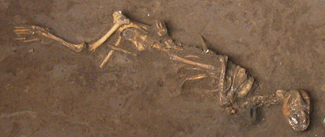Roderick Campbell’s Research on Animal Sacrifice in Early China Featured in Scientific American
This article by Marc LeBlanc first appeared in ISAW Newsletter 24, Spring 2019.
 Roderick Campbell, Associate Professor of East Asian Archaeology and History at ISAW, and his research on animal sacrifice and human-animal relations in Early China have recently been featured in several prominent and widely distributed publications, including Scientific American (May 3rd), Sapiens (April 16th), Live Science (May 7th), and The Atlantic (April 18th). In a Scientific American article, entitled “Uncovering the Sacrificial Puppies of the Shang Dynasty,” science journalist Joshua Rapp Learn highlights the work of Campbell and his research collaborator Zhipeng Li of the Chinese Academy of Social Sciences Institute of Archaeology on dog bones recovered from Early Chinese burial sites.
Roderick Campbell, Associate Professor of East Asian Archaeology and History at ISAW, and his research on animal sacrifice and human-animal relations in Early China have recently been featured in several prominent and widely distributed publications, including Scientific American (May 3rd), Sapiens (April 16th), Live Science (May 7th), and The Atlantic (April 18th). In a Scientific American article, entitled “Uncovering the Sacrificial Puppies of the Shang Dynasty,” science journalist Joshua Rapp Learn highlights the work of Campbell and his research collaborator Zhipeng Li of the Chinese Academy of Social Sciences Institute of Archaeology on dog bones recovered from Early Chinese burial sites.
Campbell and Li’s scholarly paper on this topic, “Puppies for the Ancestors: The many roles of Shang dogs,” recently appeared in Archaeological Research in Asia (March 2019) and documents the practice of burying sacrificial puppies alongside humans in Shang China. Contradicting earlier studies that speculated that these dogs were beloved pets who would provide companionship to the deceased in the afterlife, Campbell and Li highlight the young age of the sacrificed dogs and suggest that they were most likely from the ancient equivalent of puppy mills or from the litters of strays. Although Campbell’s research deals with burials from over three millennia ago, the wide audience and popular interest in his work are a testament to an ongoing and intense fascination in mankind’s relationship with animals from antiquity to the present day.